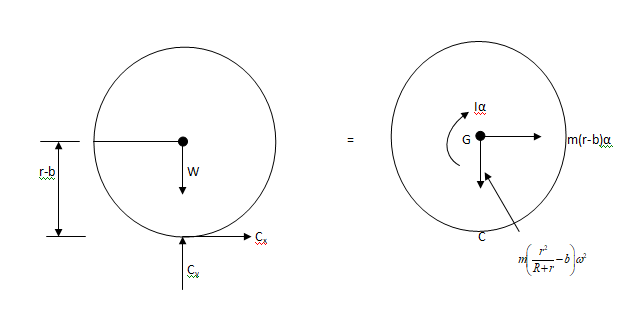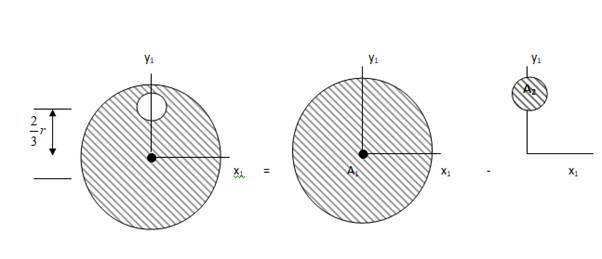
(a)
The force in the patellar tendon.
Explanation of Solution
Given information:
Cylinder weight with hole = 16 lb
Cylinder weight without hole = 15 lb
Angular velocity = 5 rad/s

Schematic of cylinder 1

Figure A
Unit
Angular acceleration of cylinder be
Let mass centre of the cylinder be G at a distance b from centre A.
Let point P coordinates with point C be
Let point G coordinates with point C be
Let point A coordinates with point C be
Point C acceleration,
Here,
Here,
Hence,
At any location on the cylinder, acceleration is
Point G acceleration,
Point A acceleration,
Substitute
Point A acceleration,
Substitute the above in equation B,
Point A velocity,
Point A acceleration vertical component,
Substitute the above in equation C,
Effective force,
Cylinder free body diagram

Figure B
Moment at point C from above figure,
From equation D, angular acceleration is zero.
Conclusion:
The cylinder angular acceleration is zero.
(b)
Components of the reaction force between the cylinder and the ground.
Explanation of Solution
Given information:
Cylinder weight with hole = 16 lb
Cylinder weight without hole = 15 lb
Angular velocity = 5 rad/s

Forces horizontal component from figure B,
Here,
Hence,
Forces vertical component from figure B,
Cylinder as combination of hole and solid is shown below

Solid cylinder area,
Solid centre of gravity in vertical direction,
Hole area,
Hole centre of gravity in vertical direction,
Equilibrium equation,
Substituting in equation E we get,
Conclusion:
The horizontal component reaction is zero and vertical reaction is
Want to see more full solutions like this?
Chapter 16 Solutions
Vector Mechanics For Engineers
- A 9-in-radius cylinder of weight 18 lb rests on a 6-lb carriage. The system is at rest when a force P of magnitude 2.5 lb is applied as shown for 1.2s. Knowing that the cylinder rolls without sliding on the carriage and neglecting the mass of the wheels of the carriage, determine the resulting velocity of (a) the carriage, (b) the center of the cylinder.arrow_forwardA uniform 144-lb cube is attached to a uniform 136-lb circular shaft as shown, and a couple M with a constant magnitude is applied to the shaft when the system is at rest. Knowing that r = 4 in., L= 12 in., and the angular velocity of the system is 960 rpm after 4 s, determine the magnitude of the couple M.arrow_forwardThe mechanism shown is one of two identical mechanisms attached to the two sides of a 200-lb uniform rectangular door. Edge ABC of the door is guided by wheels of negligible mass that roll in horizontal and vertical tracks. A spring with a constant k is attached to wheel B in such a way that its tension is zero when 0 = 30°, Knowing that the door is released from rest in the position 0 = 45° and reaches the vertical position with an angular velocity of 0.6 rad/s, determine the spring constant k.arrow_forward
- A semicircular panel with a radius r is attached with hinges to a circular plate with a radius r and initially is held in the vertical position as shown. The plate and the panel are made of the same material and have the same thickness. Knowing that the entire assembly is rotating freely with an initial angular velocity of w0 , determine the angular velocity of the assembly after the panel has been released and comes to rest against the plate.arrow_forwardTwo identical 4-lb slender rods AB and BC are connected by a pin at B and by the cord AC. The assembly rotates in a vertical plane under the combined effect of gravity and a 6-lb·ft couple M applied to rod AB. Knowing that in the position shown the angular velocity of the assembly is zero, determine (a) the angular acceleration of the assembly, (b) the tension in cord AC.arrow_forwardTwo uniform cylinders, each of mass m = 6 kg and radius r = 125 mm, are connected by a belt as shown. Knowing that at the instant shown the angular velocity of cylinder A is 30 rad/s counterclockwise, determine (a) the time required for the angular velocity of cylinder A to be reduced to 5 rad/s, (b) the tension in the portion of belt connecting the two cylinders.arrow_forward
- A drum of 4-in. radius is attached to a disk of 8-in. radius. The disk and drum have a total weight of 10 lb and a combined radius of gyration of 6 in. A cord is attached as shown and pulled with a force P of magnitude 5 lb. Knowing that the disk rolls without sliding, determine (a) the angular acceleration of the disk and the acceleration of G, (b) the minimum value of the coefficient of static friction compatible with this motion.arrow_forwardThe 10-in.-radius brake drum is attached to a larger flywheel which is not shown. The total mass moment of inertia of the flywheel and drum is 22 lb ⋅ ft ⋅ s 2 and the coefficient of kinetic friction between the drum and the brake shoe is 0.41. Knowing that the initial angular velocity is 255 rpm clockwise, determine the force which must be exerted by the hydraulic cylinder at point B if the system is to stop in 85 revolutions. determine the force which must be exerted by the hydraulic cylinder at point B if the system is to stop in 85 revolutions. DO NOT ROUND OFF IN THE SOLUTION. ROUND OFF ONLY IN 2 DECIMAL PLACE IN THE FINAL ANSWER.arrow_forwardIn the engine system shown l = 250 mm and b = 100 mm. The connecting rod BD is assumed to be a 1.2-kg uniform slender rod and is attached to the 1.8-kg piston P. During a test of the system, crank AB is made to rotate with a constant angular velocity of (400) rpm CW with no force applied to the face of the piston. Determine the velocity and acceleration of the piston P when θ = 90°. (Neglect the effect of the weight of the rod.)arrow_forward
 Elements Of ElectromagneticsMechanical EngineeringISBN:9780190698614Author:Sadiku, Matthew N. O.Publisher:Oxford University Press
Elements Of ElectromagneticsMechanical EngineeringISBN:9780190698614Author:Sadiku, Matthew N. O.Publisher:Oxford University Press Mechanics of Materials (10th Edition)Mechanical EngineeringISBN:9780134319650Author:Russell C. HibbelerPublisher:PEARSON
Mechanics of Materials (10th Edition)Mechanical EngineeringISBN:9780134319650Author:Russell C. HibbelerPublisher:PEARSON Thermodynamics: An Engineering ApproachMechanical EngineeringISBN:9781259822674Author:Yunus A. Cengel Dr., Michael A. BolesPublisher:McGraw-Hill Education
Thermodynamics: An Engineering ApproachMechanical EngineeringISBN:9781259822674Author:Yunus A. Cengel Dr., Michael A. BolesPublisher:McGraw-Hill Education Control Systems EngineeringMechanical EngineeringISBN:9781118170519Author:Norman S. NisePublisher:WILEY
Control Systems EngineeringMechanical EngineeringISBN:9781118170519Author:Norman S. NisePublisher:WILEY Mechanics of Materials (MindTap Course List)Mechanical EngineeringISBN:9781337093347Author:Barry J. Goodno, James M. GerePublisher:Cengage Learning
Mechanics of Materials (MindTap Course List)Mechanical EngineeringISBN:9781337093347Author:Barry J. Goodno, James M. GerePublisher:Cengage Learning Engineering Mechanics: StaticsMechanical EngineeringISBN:9781118807330Author:James L. Meriam, L. G. Kraige, J. N. BoltonPublisher:WILEY
Engineering Mechanics: StaticsMechanical EngineeringISBN:9781118807330Author:James L. Meriam, L. G. Kraige, J. N. BoltonPublisher:WILEY





